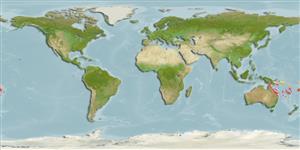>
Eupercaria/misc (Various families in series Eupercaria) >
Labridae (Wrasses) > Corinae
Etymology: Thalassoma: Greek, thalassa = the sea + Greek, soma = body; the colour of the sea (Ref. 45335); nigrofasciatum: Name from Latin, referring to the presence of black bars on the body.
More on author: Randall.
Environment: milieu / climate zone / kisaran kedalaman / distribution range
Ekologi
laut berasosiasi dengan karang; kisaran kedalaman 0 - 15 m (Ref. 57555). Tropical; 7°S - 32°S, 142°E - 173°W
Western Pacific.
Size / Weight / umur
Kematangan: Lm ? range ? - ? cm
Max length : 20.0 cm SL jantan/; (Ref. 57555)
deskripsi pendek
Kunci identifiaksi (pengenalan) | Morfologi | Morfometrik
Duri punggung (Keseluruhan (total)) : 8; duri punggung lunak (Keseluruhan (total)) : 13; Duri dubur: 3; Sirip dubur lunak: 11; vertebrata, bertulang belakang: 25. Diagnosis: Dorsal rays VIII,13. Anal rays III,11, the first spine, when detectable is very slender and short. Pectoral rays 15-16 (usually 15). Lateral line scales 26-27. Head naked, except for a small patch of scales dorsally on opercle. Gill rakers 20-23. Body depth 5.9-3.6 in SL; head length (HL) 3.1-3.4 in SL; snout length 8.4-9.8 in SL; caudal peduncle depth 6.2-6.65 in SL; pectoral fins 4.0-4.3 in SL; pelvic fins 6.3-6.9 in SL. The caudal fin is truncate in young individuals, becoming strongly lunate with filamentous lobes in adult males. The initial phase is white with postorbital head and anterior body above pectoral-fin base black with an oblique yellow band above dorsal edge of opercle, a black bar over last 4 or 5 dorsal spines continuing ventrally across body, its posterior edge vertical, and a broader black bar over last 9 soft rays of dorsal fin, across the body, and posterior anal fin; a black spot on first 2 membranes of dorsal fin; the terminal males with yellow partly replacing the white, a salmon pink patch on chin, and blue ventrally on head and chest (Ref. 57555).
Body shape (shape guide): fusiform / normal.
Found solitary or in groups, most commonly on outer reef areas, and also found in coastal reefs, lagoons and tide pools (Ref. 57555, 90102).
Life cycle and mating behavior
Kematangan | Reproduksi, perkembang biakan | Pemijahan | telur-telur | Fecundity | Larva
Oviparous, distinct pairing during breeding (Ref. 205).
Randall, J.E., 2003. Thalassoma nigrofasciatum, a new species of labrid fish from the south-west Pacific. aqua, J. Ichthyol. Aquat. Biol. 7(1):1-8. (Ref. 57555)
Status IUCN Red List (Ref. 130435: Version 2025-1)
ancaman kepada manusia
Harmless
penggunaan manusia
Alat, peralatan
laporan khas
muat turun XML
Sumber internet
Estimates based on models
Preferred temperature (Acuan
123201): 24.6 - 28.5, mean 26.6 °C (based on 405 cells).
Phylogenetic diversity index (Acuan
82804): PD
50 = 0.5000 [Uniqueness, from 0.5 = low to 2.0 = high].
Bayesian length-weight: a=0.00977 (0.00430 - 0.02222), b=3.05 (2.88 - 3.22), in cm total length, based on LWR estimates for this Genus-body shape (Ref.
93245).
Trophic level (Acuan
69278): 3.5 ±0.4 se; based on size and trophs of closest relatives
Daya lenting (Acuan
120179): sedang, Waktu penggandaan populasi minimum 1.4 - 4.4 tahun (Preliminary K or Fecundity.).
Fishing Vulnerability (Ref.
59153): Low vulnerability (14 of 100).
🛈
Nutrients (Ref.
124155): Calcium = 72.3 [42.9, 120.5] mg/100g; Iron = 0.646 [0.373, 1.205] mg/100g; Protein = 18.5 [15.6, 20.7] %; Omega3 = 0.138 [0.088, 0.214] g/100g; Selenium = 20.6 [12.2, 37.3] μg/100g; VitaminA = 145 [44, 526] μg/100g; Zinc = 1.63 [1.14, 2.59] mg/100g (wet weight);
